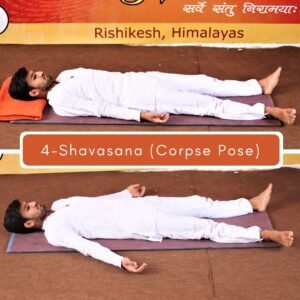Yoga brings balance, order, and harmony to our daily lives. Of all the various yoga poses, the rebound pose is one of a kind. This yoga resets the body and mind. Therefore, rebound pose yoga is trending in the modern yoga communities. This yoga is grounded in the themes of renewal and presence.
Rebound yoga refers to the transitional resting posture which gets practised between more intense asanas. This yoga is a part of Yin yoga. Whether you are a beginner or an experienced practitioner, this yoga will be great for your relaxation and rejuvenation.
Rebound yoga is a practice in relaxation and equality. This yoga is done at the fag end of the yoga session. It enables your body to receive all the gifts of your yoga practice. As you lie in your immobile condition while practising yoga, your muscles relax, your heart rate decreases, and your mind attains peace. In this post, we take a look at the history, benefits, and precautions of rebound pose yoga.
History of Rebound Yoga
Rebound yoga was inspired by Yin yoga, created in the 20th century by Paulie Zink. Over time, this yoga was popularized by Paul Grilley and Sarah Powers. This specific yoga pose works on the connective tissues as well and includes long-held passive yoga poses.
Rebound is the recovery from each yoga pose, where the body is in a quiet, passive state of relaxation. Rebound yoga became increasingly preferred by yoga experts and practitioners, most importantly for its meditative benefits.
How to Practice Rebound Pose Yoga?
Read on to learn how to do rebound pose yoga. Here’s what you’ll need to do;
- Find somewhere quiet and dimly lit.
- Grab your yoga mat or bolster.
- Begin with some lighter yoga poses (we recommend starting with dragon, butterfly, or sphinx yoga).
- Hold each yoga pose for two to five minutes.
- Once you feel through a pose, lie flat on your back or sit in a comfortable position.
- Hold still for 30-60 seconds.
- Concentrate on the sensation of breath.
- Allow your body to assimilate the stretch that you did previously.
- Sensations such as warmth, tingling or an emotional response appear in your body.
- Repeat the cycle: stretch, rebound, next posture.
Benefits of Rebound Yoga
Rebound yoga offers multiple benefits. By incorporating calmness after every pose, the practice promotes healing and integration on multiple levels.
Nervous System Relaxation
Rebound yoga stimulates the parasympathetic nervous system – the digest and rest mechanism in the body. While the connective tissues are engaged in the Yin pose, the Rebound pose enlists the nervous system to heal from within. Therefore, this yoga pose is beneficial to lower stress hormones while helping get better sleep, and balancing heart rate and blood pressure. It also enhances the immune response.
Increase Body-mind Awareness
The pause in the rebound yoga creates an internal space. During the process, you will observe the aftereffects. Thus, it helps to increase body and sensory awareness. This yoga encourages mindfulness and builds intuition about your body’s needs. Also, it helps to cultivate better lifestyle habits.
Integrative Physical Recovery
After passive stretching, the muscles and fascia face micro adjustments. The rebound period allows the tissues to recover and integrate before heading towards the next posture. Thus, rebound pose yoga helps to reduce the risk of overstretching or injury. It improves body elasticity and mobility. This yoga also encourages a holistic and balanced flow of movement.
Better Emotional Regulation
Emotional memory is stored in the flesh of the human system in the fascia and connective tissue. When the tissues release in Yin postures, the emotional energy can rise. The rebound yoga provides a calm and safe place for some of those feelings to rise to the surface and begin to restore themselves. It allows you to express pent-up feelings of anger, sorrow, and fear. Thus, you get emotional clarity. Rebound Yoga Rebound yoga is great for when you are anxious or emotionally overwhelmed.
Energetic Rebalancing
In traditional Indian and yogic energy systems, energy passes through the nadis or meridians. Rebound yoga is a way to go back and redistribute that energy, to find some balance. It is for this reason that this yoga position unblocks the energy channels and improves the life force (vitality). It can assist in balancing emotional and physical energy.
Encourages Restorative Rest
These days, almost everyone is affected by insomnia or depression because of their hectic, active schedule. Can’t sleep on the yoga mat. Rebound poses resemble the relaxing winding down, to take the work out for the full sleep of CW Yoga Nidra.
It allows the body to sleep while the mind rests lightly. So, this is a kind of mental reset button yoga that can help bring back mental clarity and energy. In no time, it is the most thorough brace for the nervous system.
Supports Meditative Presence and Inner Calmness
The pause during the rebound yoga gives the mind permission to let go of doing. With practice, the rebound pose becomes a form of moving meditation. Thus, this yoga helps to improve focus and concentration. It also encouraged detachment from external stressors. This yoga also deepens your spiritual or meditative practice. Rebound poses cultivated presence and awareness in daily life.
Builds Patience
Rebound poses help to challenge our tendency to keep ourselves moving. The steadiness teaches us to let go of effort and embrace the present moment. Thus, this yoga helps to break patterns of restlessness and impatience. It trains your mind to accept your inner state without any judgment and supports mindfulness in your daily life.
Who Can Practice Rebound Pose Yoga?
Rebound pose yoga is very accessible. As this yoga emphasizes mindfulness, stillness, and passive postures, everyone can practice it. Beginners can start practising this yoga at a gentle and slow pace. They don’t need any advanced flexibility or strength. You can take a longer rest phase to experience your internal sensations.
Older adults can also practice rebound yoga, as this yoga posture is joint-friendly and has low impact. It supports flexibility, balance, and increases relaxation.
This yoga posture is also good for pregnant women. It helps to reduce physical tension and gives comfort in the lower back. Also, this yoga promotes emotional relief. You can use props for better support and comfort.
People with a busy life schedule or emotional overwhelm can do this yoga. This yoga takes minimal time and space. At the same time, it provides quick mental relief. If you are suffering from depression, this yoga will be best for you as it calms the nervous system perfectly. It encourages emotional stability through stillness.
Precautions of Rebound Yoga
- You must understand and listen to your body during the yoga practice. Your sensations should not turn into pain.
- Make sure to use props that will support your body with cushions or bolsters.
- You must practice on an empty or light stomach.
- You must consult a healthcare provider if you have high blood pressure, recent injuries, and spinal issues.
Wrapping Up
The Rebound pose is about integration, resting and reflecting. These are generally neglected in more dynamic yoga forms. You are in charge at whatever level you wish; whether you are advanced or just starting, you can incorporate rebound poses into your workouts each day. It also helps to quiet your mind and brings great enhancement to your overall yoga practice. So stay calm and begin your yogic journey today!
Also Read:




